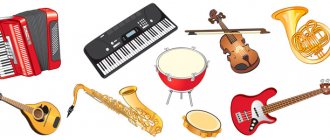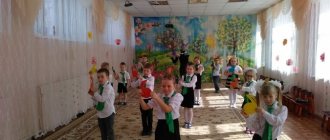Methodology for organizing music listening
— in any version of the music performance it should sound high quality;
- it is necessary that during the perception there is complete silence in the class, and students who are ready to answer do not raise their hands until the music ends;
- the teacher must listen carefully to the music with the children, it is unacceptable to engage in extraneous activities and demonstrate his indifference to the music being played.
3. Analysis and analysis of what you listened to
:
- first, the task assigned to the hearing must be solved during the conversation with the children;
- during the analysis-analysis, the teacher introduces new information, asks additional questions that deepen the children’s understanding of the content of the work and the central concept of the lesson;
— the teacher must lead the analysis and analysis, without giving ready-made answers, stimulating the creative initiative of students and the independence of their thinking;
- if such a need arises during the conversation, then you can additionally listen to the corresponding fragments of the work;
— it should be remembered that in the process of analysis the main attention should be paid to the meaningful, expressive side of the music;
- this stage of listening should not be unnecessarily drawn out, and should not turn into “near-musical” conversations;
- upon completion of the analysis, the teacher sums it up by asking the students 2-3 questions;
— further, schoolchildren are given a new task for repeated listening, which acts as a task that must be completed in the process of musical perception.
4. Rehearing
:
- carried out with an additional type of musical activity (playing musical instruments, vocalizing a melody, plastic intonation, musical-rhythmic movements) or with a creative task (drawing music, its color modeling, creating an essay, etc.), with musical and didactic games , music research tasks can also be used;
- the work can be listened to several times until the children complete their creative task or participate sufficiently in the game, however, they should adhere to the time planned for this part of the lesson;
- if necessary, repeated listening can be moved to one of the following parts of the lesson or even to another lesson (if the work is large).
5. Summing up the hearing
: represents a series of questions from the teacher to schoolchildren, which allow them to emphasize the basic concepts introduced during the listening process, consolidate and clarify them, and check how much the children have mastered the content of the listening. In terms of time, listening to music should not take up more than half of the lesson, although there may be pedagogically justified exceptions.
Listening to music in preschoolers
Oksana Semukhina
Listening to music in preschoolers
Educational program for preschoolers in the section “ Listening to music ”
has specific tasks:
introduce children to artistic examples of modern, classical, and folk music ;
develop musical sensitivity, the ability to respond emotionally to feelings expressed in music ;
distinguish musical images , features of their development;
give initial information about music , lead to memorizing musical works , distinguishing their content,
character, means of expression, to form an evaluative attitude.
In preschool age , when laying the elementary foundations of musical culture , it is necessary to take into account the extremely limited age capabilities of children.
In the first or second year of life, babies distinguish the general mood, the nature of the music , and therefore perceive its emotional content.
In the younger groups of kindergarten, due to instability of attention, children better perceive small works that are bright in their images, especially songs. The expressive intonations of the singing voice and the facial expressions of the singer especially captivate them. External manifestations of emotions are characteristic of this age - gestures of surprise and admiration, expressed in jumping and clapping. However, the feelings evoked by music arise quickly and disappear just as quickly.
Four- and five-year-old preschoolers have some emotional stability and respond very vividly, sometimes violently and cheerfully, to a dance melody. Works of a light, moving nature induce a calmer state in them. An interest in the content of the works appears, and questions arise related to the desire to find out what the music . Individual manifestations of musical memory , the desire to talk about impressions after listening to a song or play .
Children 5-7 years old have sufficiently developed voluntary attention, the ability to concentrate, and grasp music in more detail . Their musical curiosity and interest are conscious and manifest themselves in the need for repeated communication with their favorite works. A certain ability to observe is also noted. The children are able to feel the general mood of the music and follow the development of the artistic image. They note some of the most expressive musical means and find original, independent definitions: “What kind of music is slow , heavy”
(about V. Rebikov’s play
“The Bear”
).
Children are able to compare individual phenomena of reality with impressions from the perception of music . For example, after listening to “Cavalry”
by D. Kabalevsky, the boy remarked: “I saw the cavalrymen, they were riding fast, so brave, brave.
The music speaks about them correctly.
I will be brave too." The content of the program includes three main elements:
familiarization with musical works , nurturing a love for them, memorizing them, accumulating musical impressions ;
instilling the skills of a culture of listening to music ;
the formation of musical taste in the process of accumulating auditory impressions and initial information about music .
Let's look at these areas in more detail.
music listening program is built on the basis of a clearly thought-out system. It consists of works in which musical images , feelings and moods become more diverse, and the range of life phenomena conveyed in music . Means of expression are also becoming more complex. It is known that D. B. Kabalevsky used a thematic structure of his program. This principle can also be used when drawing up a program for music education for children of senior preschool age .
Themes organize the process of forming children's musical perception . The sequence of themes introduces the child to the world of music , enriches his emotional experience, and, in addition, the child begins to understand that musical works reflect life phenomena and they can be expressed by means of musical expressiveness .
The program is based on three main themes.
The first topic: “What feelings does music ?”
Children are introduced to genres, the different nature of works, and their vocabulary is expanded
(festive, solemn, tender, sad, affectionate, cheerful)
.
So this topic directs children's attention to the emotional content of music .
Second topic: “What does the music ?”
Children are introduced to the programmatic and figurative nature
of music : it turns out that it can tell about the character of the hero, his mood, natural phenomena, and life events.
Third topic: “How does music ?”
Children are introduced to the development of artistic images and means of expression -
music has its own language , its own speech (melody, rhythm, dynamic, register nuances, tempo changes)
.
Gradually, children become familiar with musical speech .
Of course, the division of topics is very conditional, since by drawing the attention of children to one of them, the teacher touches on other topics. By the end of his stay in kindergarten, the child is able to recognize the work as a whole, its individual parts, chorus, and conclusion. Having a stock of familiar musical works , he can distinguish between their types and characteristic features (march, dance, lullaby)
. He forms initial ideas about the content of songs, plays, their form (introduction, conclusion, chorus, chorus, part, the most striking means of expression.
Consistent fulfillment of the requirements of the music listening leads to the harmonious musical development of the preschooler .
The love for music and the need for it are formed in a child primarily in the process of listening to it, thanks to which children develop musical perception and lay the foundations of musical culture. V. Sukhomlinsky emphasized: “If in early childhood the beauty of a musical work is conveyed to the heart, if the child feels the multifaceted shades of human feelings in sounds, he will rise to a level of culture that cannot be achieved by any other means.” In our lives, music sounds everywhere - on radio, television, recordings, theaters and cinemas. But such encounters between children and music are random, and the development of musical sensitivity requires consistent guidance in the listening process. To form an aesthetic perception of music, it is important not only to experience and understand its content, but also to distinguish between individual means of musical expression. D.B. Kabalevsky drew the attention of teachers to the fact that music will only fulfill its aesthetic, cognitive and educational role when children truly learn to listen to it and think about it.
At the beginning of the 20th century. many major musicians (B.A. Asafiev, B.L. Yavorsky, Ts. Cui, S.M. Maikapar and others) paid great attention to this issue. V.N. Shatskaya, a well-known teacher-musician, began work on developing music listening skills in pre-revolutionary times and continued it in the first experimental station of the People's Commissariat for Education, organized in 1919 - a scientific and methodological center for preschool education. The issues of selecting musical material for listening and teaching methods were also dealt with at the beginning of the century by: N.A. Metlov, T.S. Babajan, E.A. Dimoglo, V.N. Zakolpskaya, E.M. Dubyanskaya, T.A. Vilkoreiskaya, L.N. Mikhailova. In their works, they convincingly showed that for children to understand a musical image, the combination of the musical sequence itself with the poetic word of a song, the program of an instrumental piece, and action in a game or dance is of considerable importance. Subsequently, issues of listening—perception of music—were considered by musician-psychologists B.M. Teplov, K.V. Tarasova; scientific workers-teachers N.A. Vetlugina, I.L. Dzerzhinskaya, S. Sholomovich, O.P. Radynova; practicing teachers S.I. Bekina, E. Sokovnina, N. Frenkel, T. Lomova, E. Dubyanskaya and many others.
To develop the ability to listen and perceive music, musical-sensory education of the child is necessary. It involves distinguishing sounds by pitch, timbre, sound strength, and duration.
It is known that, compared to instrumental music, vocal music has a greater influence on children, since it is based on the unity of musical and literary texts, and the child always associates the sound with any specific images. The lyrics deepen his understanding of his surroundings. Composers M. Krasev, V. Gerchik, M. Starokadomsky, M. Filippenko, M. Rauchwerger, E. Tilicheeva, T. Popatenko, M. Iordansky, V. Vitlin, Yu. Ostrovsky and others created many children's songs of various themes. Children also willingly listen to expressive folk melodies.
software is mainly used
instrumental music - that is, equipped with a literary program or title in which the composer specifies the figurative content of the work.
Children also listen to non-program
music that expresses only a certain mood. Basically, these are works for exercises, non-plot games, dances that children will perform in the future, or lullabies, dance pieces that children perceive well, but will not translate into movement.
Listening to music is an active internal process of concentration, which gives children the opportunity to perceive and understand various types and genres of musical art. Musical development is a result that must be strived for in the process of education and training.
In the process of listening to music, in unity with musical and aesthetic, the tasks of the child’s comprehensive development are also realized: his moral character is improved, mental abilities are formed, and physical condition is strengthened. Music helps a child not only experience beauty, but also create it. When systematically listening to music, children begin to distinguish and understand its means of expression, genres, and composition of works, which naturally deepens aesthetic feelings. Listening to music greatly contributes to the development of musical abilities, as well as melodic, harmonic, rhythmic and timbre hearing. Listening deepens children's understanding of their surroundings. In the process of necessary speech practice, which takes place in the analysis of musical works, the mental activity of preschool children is formed. “Music is a powerful source of thought. Without musical education, the full mental development of a child is impossible,” wrote the outstanding teacher V. Sukhomlinsky. With the help of conversations, questions, musical riddles, children learn to notice the similarities between works or their parts, the originality of each of them; correlate the content of works with the surrounding life; master special musical terminology. When organizing the process of listening to music in children, voluntary attention and volitional qualities are formed. The brightness and impressive power of the musical sound deepen the content of the poetic text of the song. That is why music has such a strong impact on the feeling of love for one’s native country, its nature, and arouses interest in the life of other peoples.
Thus, while listening to music with children, the teacher introduces them to musical works of various content, deepens and expands the range of their ideas, cultivates feelings, musical perception and musical taste.
When determining tasks for listening to music, it is necessary to take into account the age capabilities of children.
Children already in early childhood distinguish the general mood, the nature of music, and perceive its emotional content.
In younger groups, children have a relatively weak stability of attention and rapid switching - they better perceive small works that are bright in their images. They respond more emotionally to vocal music. The expressive intonations of the singing voice, conveying feelings, and the facial expressions of the teacher especially captivate children. This age is characterized by external manifestations of feelings when listening - gestures of surprise, joy, expressed in jumping, clapping. Often, after listening to music that they liked, children have pleasant memories - a new dress, a toy, a holiday. The feelings evoked by music arise quickly and disappear quickly. Although children 4-5 years old already have a noticeable certain stability in musical experiences. The feelings evoked by music are more differentiated. They respond very lively, vigorously, cheerfully to cheerful dance melodies; they become more interested in the content of the music than children. Children often want to know what the music is saying. Individual manifestations of auditory observation are noted.
In children aged 5-7 years, the characteristics of musical perception change significantly as a result of the experience they gain in listening to music. Voluntary attention is developed, the ability to concentrate when listening, and to capture the details of performance.
Children are distinguished by their curiosity and begin to take a more conscious interest in music. Favorite works appear that they are ready to listen to repeatedly. When listening again, children notice new, previously unnoticed details of the construction of a musical work. They are able to capture and establish not only the general mood and character of the work, but also their change during the development of musical images. Children name and list individual, most expressive musical means and independently find unique definitions for this. They are able to compare individual phenomena of reality with the impressions they receive from music.
Systematic enrichment with musical impressions and targeted guidance in the process of listening to music contributes to the development of children’s musical perception.
The program for listening to music in kindergarten is determined primarily by educational tasks, rather than by learning goals, since the information children receive from listening to music is still very limited. The main goal of this type of activity is to introduce children to music, to cultivate a sustainable interest and love for it.
In accordance with this goal, the main educational task of listening to music is the formation of the initial foundations of musical culture, namely:
♦ introducing children to modern and classical works that are accessible to their perception, as well as folk music, differentiating them by genres and types;
♦ formation in children of musical sensitivity, the ability to respond emotionally to music, to empathize with the feelings expressed in it;
♦ development of the ability to memorize musical works, their content, character, means of musical expression; gradual formation of ideas about music;
♦ fostering an evaluative attitude towards music and its performance, which is the initial manifestation of musical taste;
♦ developing the skill of listening to music;
♦ creation of a fund of favorite children's works.
The content of the music listening program can be divided into three main areas:
Familiarization with musical works, their memorization, accumulation of musical impressions;
Development of musical abilities and cultural listening skills;
Development of the ability to distinguish the nature of songs, instrumental pieces, and their means of expression; formation of musical taste.
Acquaintance with musical works occurs according to a certain system. The semantic range of music—musical images in their development—is consistently becoming more complex, feelings and moods are becoming more diverse, and the range of life phenomena conveyed in music is expanding. A “fund” of favorite works is created in children’s memory, which they listen to repeatedly, recognize and distinguish. Musical memory gradually develops. A person remembers many first musical impressions throughout his life.
The skills of a culture of listening to music are formed on the basis of the ability to listen to music brought up in childhood. Children 3-4 years old are taught to listen to the rest of the song or instrumental. play to the end, and then listen to it a second time, paying attention to certain aspects of it. They develop skills of stable auditory attention. This means that the child is able to perceive music more emotionally and consciously and experience the power of its impact, which leads to the development of a culture of listening to music.
The formation of the abilities of differentiation, evaluation of musical phenomena and initial knowledge about them occurs through constant live communication with the music itself. In the process of listening to music, children receive from the teacher the necessary information aimed at explaining to them the content of what they perceive in order to encourage them to actively perceive.
At first, children are not required to formulate briefly and precisely or to memorize complex terms. Only towards the end of his stay in kindergarten does the child begin to recognize works not only as a whole, but also in individual parts. Having a stock of familiar musical works, children can distinguish by character also works unfamiliar to them (such as a march, dance, lullaby). They form initial ideas about the content of songs, instrumental pieces, their form, and means of musical expression.
Children of older groups receive information that music is created by the people, composers create. They are explained that musical works can be performed on various musical instruments both by soloists and by an ensemble of musicians or an orchestra.
Comparisons, associations, initial generalizations arise in conditions of direct perception of music. The desire to find out “what the music is talking about” forces children to listen to the sound and distinguish some musical forms and means of expression. Gradually they learn to compare the character of the music with them. Thus, cheerful, cheerful, dance melodies often correspond to a fast tempo, loud sound, and active rhythm, while sad, calm melodies often correspond to a quieter sound and slow movement. Children connect the content of the literary text of the song with its musical reflection, the name of the program instrumental piece with the nature of the music. You can set them a task: after listening, compare similar and dissimilar musical phrases and parts of a work. These comparisons are given first on brightly contrasting comparisons, and then, gradually, on less contrasting ones.
The first manifestations of an evaluative attitude towards music can be observed already in children of the middle group. Children of older preschool age have a more diverse vocabulary; they already evaluate not only musical works, but also their performance.





